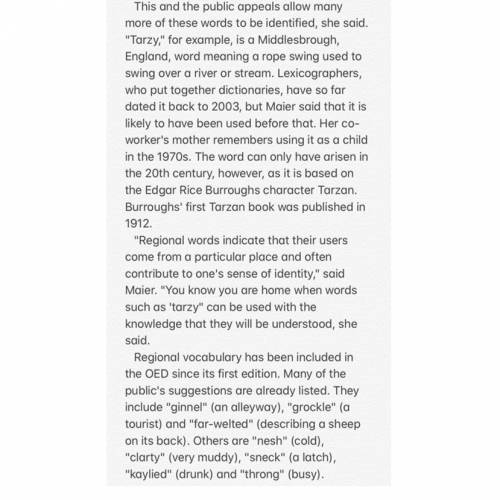
English, 19.05.2020 04:02 ethan62211
PLZZ write a short paragraph that explains the central idea of the article+use 2 details from the article to support the response.
—The English language is used in different and colorful ways around the world. The same words can be used in different ways, depending on where you live. People can also have completely different ways of saying the same thing.
The Oxford English Dictionary (OED) is asking the public to help it find the regional differences in English around the world. It wants to expand its record of the language, with early submissions ranging from New Zealand's "munted" to Hawai's "hammajang."
Last year, the OED, BBC Radio and the Forward Arts Foundation teamed up to find and define local words in the United Kingdom. It resulted in more than 100 new regional words and phrases being added to the dictionary. They ranged from Yorkshire's "ee bah gum" (oh!) to the northeast's "cuddy wifter," a left- handed person. Yorkshire is a county in northern England.
Now, the OED is widening its search to English speakers around the world. Associate editbr Eleanor Maier called the early response "phenomenal." Editors are beginning to draft a range of suggestions to include in the dictionary.
These range from Hawaii's "hammajang," meaning "in a disorderly state," to the Scottish word for a swimming costume, "dookers" or "duckers." There is also New Zealand's "munted," meaning "broken or wrecked."
**Words On The Short List**
The OED is also looking to include the word "chopsy," a Welsh term for an overly talkative person, "frog-drowner," which Americans might use to describe a torrential downpour of rain, and "brick," which means "very cold" to residents of New Jersey and New York City. The dictionary is also looking at adding "round the Wrekin." It is a phrase from the middle of England, which means "in a lengthy or roundabout manner."
The dictionary has already found that, depending on location, a picture hanging off center might be described as "agley." It might also be called "catawampous," "antigodlin" or "ahoo." A loved one could be called a "doy," "pet," "dou-dou," "bubele," "alanna" or "babber."
"The OED aims to cover all types of English, including standard English, scientific and technical vocabulary, literary words, slang and regionalisms. So it's important to include these words to enable us to present a picture of the Enalish lanauage." said Maier.
The Words Where You Are appeal is looking for more suggestions. These words will go with the regional words suggested by people in the U. K. last year. In that request, BBC Radio listeners were asked to send in their local turns of phrase. Those were later used in poems by authors including Liz Berry and Hollie McNish for a National Poetry Day project.
"We were surprised and pleased by the number of regional words we were able to include as a result," said Maier. "With the public's suggestions as a starting point, we were able to unearth a rich seam of regional vocabulary."
**Words That Come From A Specific Place
Some of the words suggested in the U. K. date back centuries, such as "zamzawed." It's a term in Devon for food that has been spoiled by overcooking. Devon is a county in southwest England. Then there are more recent coinages such as "jarg," used in Liverpool to refer to something false or misleading. Liverpool is a city in northwest England. Other additions now in the OED include "antwacky," meaning old-fashioned, and "barry," meaning great, with more to come. Maier said thatit can be difficult for the OED's editors to identify regional words. The expressions are more often spoken than written down. The editors require citable evidence to include a new definition.
"In recent years, resources such as Twitter have been a great way for us to monitor the words that people are using informally in particular parts of the world," she said.
*THE REST OF ARTICLE IS ON PICTURE*


Answers: 1
Another question on English

English, 21.06.2019 20:30
Write a two-paragraph objective summary of charlotte perkins gilman's "the yellow wallpaper." identify a theme of the story and explore how characterization and setting develop that theme. one paragraph will be about character and the other paragraph will be about setting, but both paragraphs must be about the same theme. your story should include the following elements: two paragraphs, each about a different detail (character or setting) that shows the theme objective summaries that emphasize details related to each paragraph topic clear, formal, academic language that shows your professionalism you should have completed a draft of this assignment in the activity before this one. if you haven't done so, go back and complete that activity now.
Answers: 2

English, 22.06.2019 08:00
Which details from the excerpt best indicate that the tomb is a frightening place ?
Answers: 1

English, 22.06.2019 08:00
Identify the sentence with all words spelled correctly. a. ? it's your responsabilitiy to lock up. b. ? it's your responsability to lock up. c. ? it's your responsabilty to lock up. d. ? it's your responsibility to lock up.
Answers: 1

English, 22.06.2019 08:20
Throughout "sinners in the hands of an angry god," edwards uses imagery in an attempt to make readers feel angry at people who commit sins. respectful toward god and religion. fear about being sent to hell. confident that they will be saved.
Answers: 1
You know the right answer?
PLZZ write a short paragraph that explains the central idea of the article+use 2 details from the ar...
Questions

Mathematics, 11.05.2021 04:20

History, 11.05.2021 04:20

Mathematics, 11.05.2021 04:20

Mathematics, 11.05.2021 04:20

Mathematics, 11.05.2021 04:20

Mathematics, 11.05.2021 04:20

English, 11.05.2021 04:20

Mathematics, 11.05.2021 04:20







Biology, 11.05.2021 04:20


Mathematics, 11.05.2021 04:20



Mathematics, 11.05.2021 04:20



